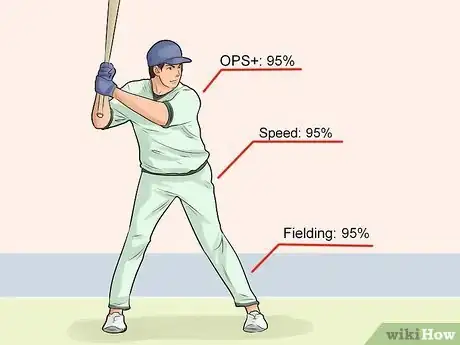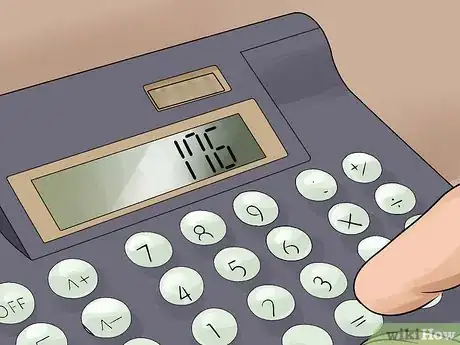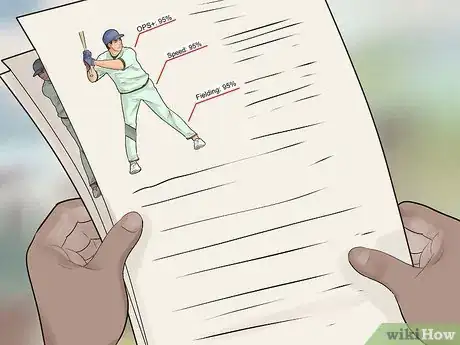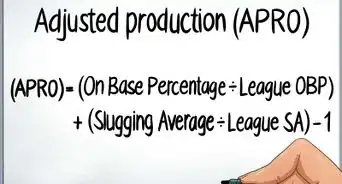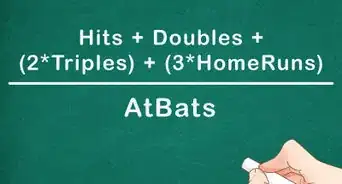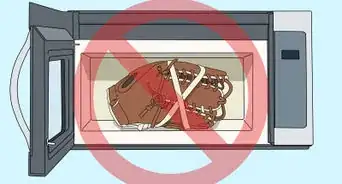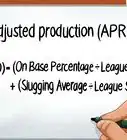wikiHow is a “wiki,” similar to Wikipedia, which means that many of our articles are co-written by multiple authors. To create this article, volunteer authors worked to edit and improve it over time.
There are 11 references cited in this article, which can be found at the bottom of the page.
This article has been viewed 207,067 times.
Learn more...
For decades, baseball fans and analysts used conventional statistics to compare players from different eras. However, statistics compiled by a player from the Dead-Ball Era couldn't be extrapolated into modern-day terms without incorporating major adjustments. A new, complex method of statistical analysis can help fans neatly define a player's value to his team with a single number. The WAR, or Wins Above Replacement, rating considers virtually every facet of a player's ability, in the proper historical context, and gives the fan an accurate estimation of the player's effectiveness. Read these guidelines if you want to learn how to calculate baseball WAR rating.
Steps
-
1Understand what WAR measures.[1] WAR is a simple representation of a series of highly complex equations. The concept was conceived by baseball statistician Sean Smith. It purports to measure the value of a player to his team, expressed in wins.[2] You can find a player's WAR rating by following a 3-step process:
- Compile the player's single-season statistics in all pertinent categories for the season you're examining.
- Determine the league average for each statistical category. You can only calculate WAR numbers after you've examined all players. A player's WAR is based on his figures compared to the league average, but is ultimately calculated against the projected statistics of a player who would replace him in his team's lineup. Replacement players usually have WAR ratings far below the league average.
- Apply the player's statistics to those of the replacement player. After finding the difference in each category, take the sum of those figures and divide by 10. The quotient is the player's WAR rating.
-
2Determine the WAR rating of non-pitchers against the league average in a variety of offensive, speed and fielding categories. These include:
- OPS+: Take the sum of the player's on-base percentage plus his slugging percentage, and compare the sum to the league average. The result yields a figure for batting runs above/below average.[3]
- Ballpark and era adjustments: You must complete further detailed analysis to incorporate the characteristics of ballparks and style of play during the season you are analyzing. Do this by examining players' statistics at individual parks and comparing the figures to the league averages. These adjustments are extrapolated onto the player's batting runs figure for a final total.[4]
- Speed: You can judge an individual player's speed against the league average by measuring several different categories. Stolen bases, caught stealing, ground ball double plays, and extra bases taken all factor into this figure. You will have to examine play-by-play records to determine a player's effectiveness in taking extra bases. Compare the player's statistics to the league average in the other categories. The results yield a figure above or below the league average that you add to the batting runs number.
- Fielding: Measure the player's defensive capabilities against the league average for putouts, assists and errors at his primary position. This produces a range figure. For infielders, add the range figure to the player's double-play number to arrive at a defensive number. Add the defensive number to the batting runs and speed numbers.
- Position adjustment: Some positions are more difficult to play than others. This is considered in WAR ratings. For example, shortstops get a +8 adjustment to their WAR. Right fielders are -8. For a complete list, search online for WAR position adjustments.
Advertisement -
3Find the replacement player's rating. To find the theoretical replacement player's rating, subtract 20 runs from the combined averages in the various categories.
-
4
Rate a Pitcher
-
1Compile a pitcher's statistics in several categories and compare each to the league average. The key statistics for finding a pitcher's WAR rating are:
- Earned Run Average: Compare the pitcher's ERA to the league average.[7]
- Defensive adjustment: Determine the defensive capabilities of the team that played behind the pitcher, compared to the rest of the league, and apply that figure to the pitcher's rating. This is done by comparing the fielding rating of each of the team's position players to the league average and applying that sum to the rating.
- Fielding Independent Pitching: F.I.P. is a tally of the 3 categories pitchers control entirely: strikeouts, walks and home runs. F.I.P., combined with average innings per start, yields a figure that represents the number of runs a pitcher must save to qualify for a win. Find the pitcher's F.I.P. and compare it to the league average.[8]
- Pitcher's winning percentage above replacement: To find the pitcher's winning percentage, calculate the average number of innings per start. This number expresses how many runs the pitcher must save to qualify for a win. Subtract the league-average F.I.P. from the pitcher's F.I.P. and divide that result by the runs-saved number. This result will be expressed as a percentage. Add .500 to this figure to get the pitcher's winning percentage.
- Use a .380 winning percentage as the benchmark for comparison. Subtract the pitcher's winning percentage from this figure to get the result.
-
2Find the pitcher's WAR rating. Take the pitcher's adjusted winning percentage above replacement and multiply it by the number of innings pitched. Divide that product by 9 to render a number that expresses how many wins the pitcher is worth.[9]
Community Q&A
-
QuestionIs it better to have a higher or lower WAR in baseball?
 Community AnswerHigher. You are tracking the number of additional wins this player gets your team by playing. That said, I don't think you can take the number literally. The best WAR in the majors right now is 7.9 (Mike Trout), but I guarantee if you were to sideline him, the Angels would lose far more than 8 games over the course of a full season vs. a replacement player.
Community AnswerHigher. You are tracking the number of additional wins this player gets your team by playing. That said, I don't think you can take the number literally. The best WAR in the majors right now is 7.9 (Mike Trout), but I guarantee if you were to sideline him, the Angels would lose far more than 8 games over the course of a full season vs. a replacement player. -
QuestionIs the replacement player the same for all teams?
 Community AnswerYes, this is the purpose of the WAR metric. It doesn't matter who the actual replacement player is; the replacement player's effectiveness is calculated based on the league average (for that season) for all stats for that position. This is what enables an apples-to-apples comparison for players that aren't just on different teams, leagues, and ballparks, but also across different eras. (Ty Cobb vs. Mike Trout, for instance.)
Community AnswerYes, this is the purpose of the WAR metric. It doesn't matter who the actual replacement player is; the replacement player's effectiveness is calculated based on the league average (for that season) for all stats for that position. This is what enables an apples-to-apples comparison for players that aren't just on different teams, leagues, and ballparks, but also across different eras. (Ty Cobb vs. Mike Trout, for instance.) -
QuestionWho has the highest WAR number in baseball?
 Community AnswerBaseball Reference currently lists Babe Ruth as the all time leader with a total of 182.5 WAR, followed by Walter Johnson (164.5) and Cy Young (163.8). Among active players, Albert Pujols leads with 100.8 WAR, followed by Mike Trout (72.8) and Justin Verlander (71.6). In the 2019 season, Cody Bellinger and Alex Bregman were roughly tied at 9.1 WAR, followed by Marcus Semien at 8.9 WAR.
Community AnswerBaseball Reference currently lists Babe Ruth as the all time leader with a total of 182.5 WAR, followed by Walter Johnson (164.5) and Cy Young (163.8). Among active players, Albert Pujols leads with 100.8 WAR, followed by Mike Trout (72.8) and Justin Verlander (71.6). In the 2019 season, Cody Bellinger and Alex Bregman were roughly tied at 9.1 WAR, followed by Marcus Semien at 8.9 WAR.
References
- ↑ http://m.mlb.com/glossary/advanced-stats/wins-above-replacement
- ↑ https://library.fangraphs.com/misc/war/
- ↑ http://m.mlb.com/glossary/advanced-stats/on-base-plus-slugging-plus
- ↑ http://m.mlb.com/glossary/advanced-stats/park-factor
- ↑ https://library.fangraphs.com/war/war-position-players/
- ↑ https://www.baseball-reference.com/about/war_explained.shtml
- ↑ http://m.mlb.com/glossary/standard-stats/earned-run-average
- ↑ http://m.mlb.com/glossary/advanced-stats/fielding-independent-pitching
- ↑ https://library.fangraphs.com/war/calculating-war-pitchers/

